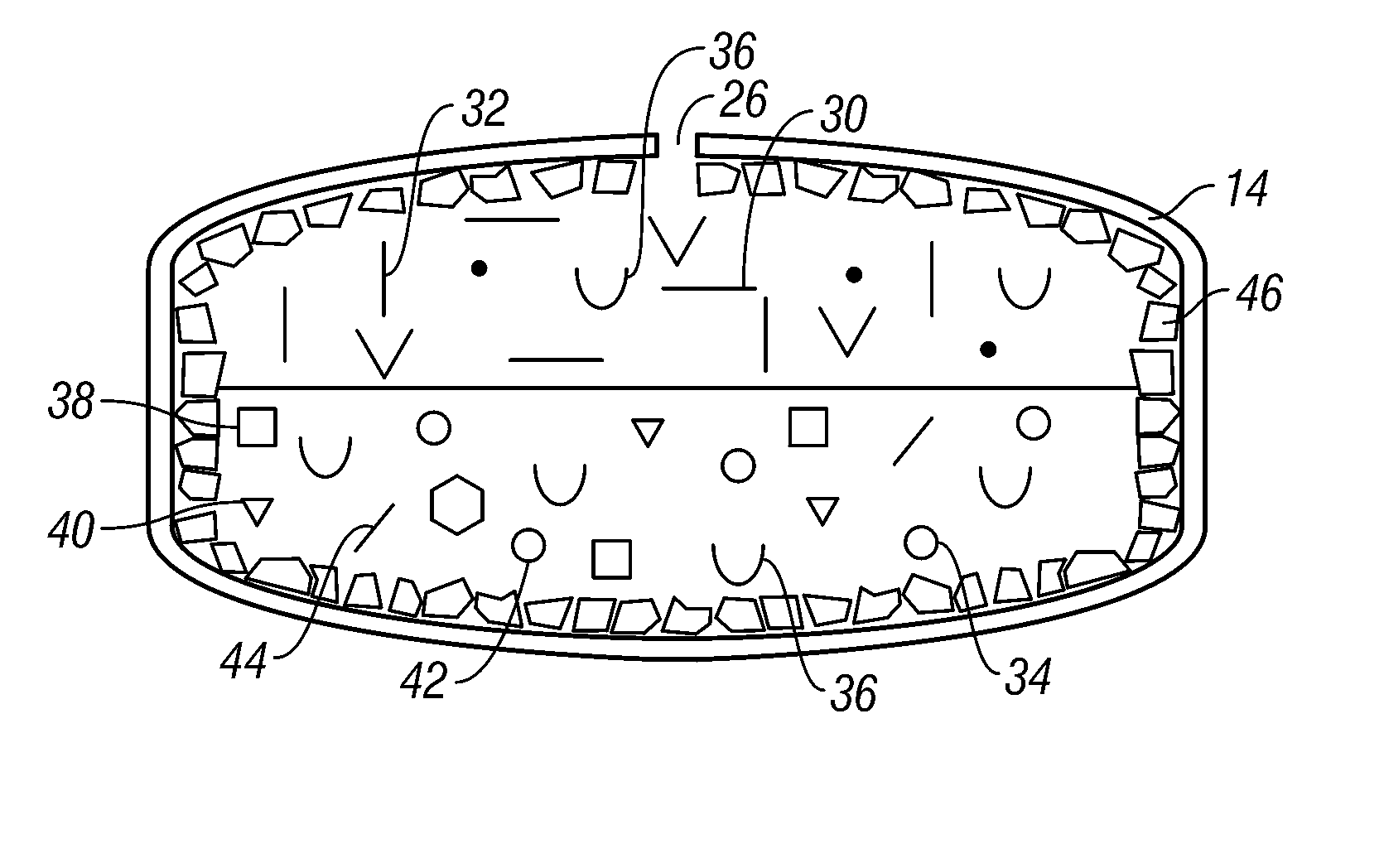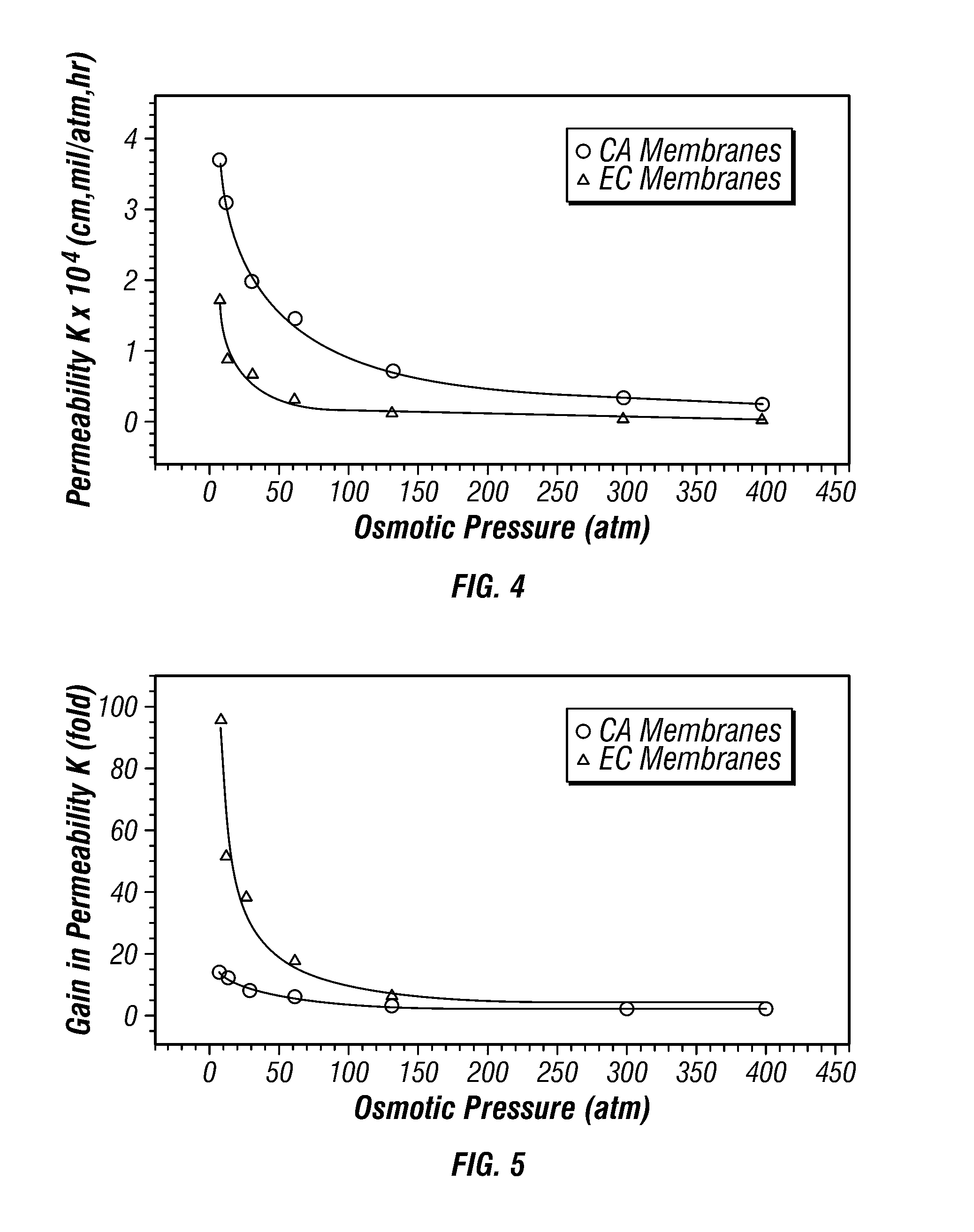Volume Efficient Controlled Release Dosage Form
a volume efficient, dosage form technology, applied in the direction of osmotic delivery, cardiovascular disorder, drug composition, etc., can solve the problems of large residual drug undelivered within the dosage form, complex fabrication of known osmotic dosage forms, and difficulty in achieving volume efficient dosage forms. , to achieve the effect of increasing the loading of active agent composition
- Summary
- Abstract
- Description
- Claims
- Application Information
AI Technical Summary
Benefits of technology
Problems solved by technology
Method used
Image
Examples
example 1
[0078] An exemplary osmosensitive membrane according to the present invention was fabricated using ethycellulose (“EC”) and hydroxypropyl cellulose (“HPC”). The osmosensitive membrane of this example included, by weight percent, 55% ethylcellulose, 40% hydroxypropyl cellulose, and 5% of a compatibilizing surfactant, polyethylene glycol 40 stearate. The ethyl cellulose had an ethoxyl content of 48.0 to 49.5 wt %, a number-average molecular weight of approximately 220,000 grams per mole, a degree of substitution of 2.46 to 2.58, and a viscosity value of 100 centipoise as a measured in a 5 wt % solution dissolved in 80 parts toluene and 20 parts ethanol. The EC material is supplied as Ethocel Standard Premium 100 cps by Dow Chemical of Midland, Mich. The hydroxypropyl cellulose had molecular weight of approximately 80,000 grams per mole and a viscosity of 300 to 700 centipoise as measured in a 10 wt % solution in water. This osmoresponsive material is supplied as KLUCEL® EFX and is man...
example 2
[0088] A candidate hydrophilic substance 46 which would swell in response to osmotic pressure for potential use in osmoresponsive membranes was screened experimentally. 15 grams of hydroxypropyl cellulose EFX were dissolved in 85 grams of 95 / 5 ethanol / water wt / wt. This solution was cast on a level glass plate, drawn with a Gardner knife having a fixed gap to evenly spread the solution, and allowed to dry. The resulting dried film was peeled from the plate and cut into sections 1 centimeter wide and 4 centimeters long. Individual film samples were weighed on an analytical balance and then were then individually bagged in a nylon mesh netting by heat sealing the edges. The mesh openings of the nylon bag were approximately 20 per inch. The weighed sample was then immersed in a solution of the nonionic osmoagent, sorbitol, having a known concentration of 932 mg per milliliter and maintained at a temperature of 37° C. Osmotic pressure of the solution had been measured to be 350 atmospher...
example 3
[0090] A candidate hydrophilic substance 46 which would swell in response to both osmotic pressure and to ionic strength for potential use in osmoresponsive membranes with osmotic core 20 formulated with an ionic osmoagent was screened experimentally. The procedures and materials detailed in EXAMPLE 2 were repeated except sorbitol was replaced with an ionic salt, sodium chloride, as the osmoagent. Sodium chloride is an electrolyte and therefore imparts ionic strength in aqueous solution. Sodium chloride concentrations of 250, 175, 125, 88, 63, 38, 25, 18, and 8 milligrams per milliliter were tested. This series of concentrations corresponds to ionic strengths of 4.28, 2.99, 2.14, 1.51, 1.08, 0.65, 0.43, 0.31, 0.14 molar and to osmotic pressures of 283, 195, 115, 78, 59, 33, 21, 14, and 6 atmospheres, respectively. The results of this test are plotted in FIG. 7.
[0091] As is illustrated in FIG. 7, swelling of the film, as represented by weight gain of the film, increased with decreas...
PUM
| Property | Measurement | Unit |
|---|---|---|
| Fraction | aaaaa | aaaaa |
| Pressure | aaaaa | aaaaa |
| Pressure | aaaaa | aaaaa |
Abstract
Description
Claims
Application Information
 Login to View More
Login to View More - R&D
- Intellectual Property
- Life Sciences
- Materials
- Tech Scout
- Unparalleled Data Quality
- Higher Quality Content
- 60% Fewer Hallucinations
Browse by: Latest US Patents, China's latest patents, Technical Efficacy Thesaurus, Application Domain, Technology Topic, Popular Technical Reports.
© 2025 PatSnap. All rights reserved.Legal|Privacy policy|Modern Slavery Act Transparency Statement|Sitemap|About US| Contact US: help@patsnap.com



